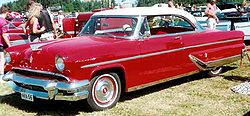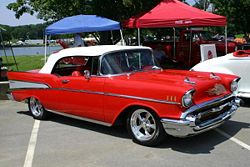- Dagmar bumpers
-
Dagmar bumpers, also known simply as Dagmars (dag-mar), is a slang term for the artillery shell shaped styling elements found on the front bumper/grille assemblies on several makes of cars produced in the 1950s, an era recognized for its flamboyant designs and prominent use of chrome details.
The term was coined by customizers in direct reference to Dagmar,[1] an early 1950s television personality well known for her pronounced cleavage on Broadway Open House. Dagmar's physical attributes were further enhanced by low-cut gowns and the shape of her bra cups, which were somewhat conical. She was amused by the tribute.
Evolution
As originally conceived by Harley Earl[2], GM Vice President of Design, the bumper guard elements would mimick exaggerated artillery shells and were placed at either end of the front bumpers of Cadillacs. Their presence was both as a styling element indicating speed (as in the speeding bullet or projectile) and as bumper guards.
However as the 1950s wore on, the element on the Cadillac grew more pronounced, and in 1957 the Cadillac Eldorado Brougham gained black rubber tips, which were referred to in slang terms as "pasties"[2].
As the 1959 model year designs approached, American car designs were beginning to shed both their rear fins and the missile shaped grille elements. In 1960 the era of the Dagmar bumper ended when Lincoln dropped the element from its 1961 Lincoln Continental.
Dagmars as a massive grille or bumper decoration competed against not only "spinners," as on the 1949 Ford and 1950 Studebaker, but also against a similar decorative element, which had a concave tip. Buick had these in a circular form both before and after the firm's stint with dagmars. Oldsmobile had these in an oval form and never used dagmars.
Vehicles sporting Dagmar bumpers
Postwar Cadillacs began sporting missile pointed bumper elements with their 1946 models. Beginning with the 1951 models, stylists began lifting these bumper guards up into the grille work, however by 1953 their shape and detail began to take on a bullet motif with the tips of the element being scored in the manner in which a bullet casing is shaped. In 1957 black rubber tips were placed on the element which was now placed at the top of the grille, approximately ten inches above the lower bumper. The element continued to become more pronounced in size through 1958, but were eliminated in the 1959 Cadillac redesign.
Mercury sprouted prominent Dagmars in 1953 and continued the look through the 1956 model year. Lincoln added Dagmars to its 1960 Lincoln and Continentals. The design took a different approach than GM, with the use of a black rubber ring separating the body of the element from the chrome tip.
Buick sported Dagmars on its 1954 and 1955 models. In 1954 the element was part of the bumper assembly; in 1955 the element moved up into the grille area.
References
- ^ Martin, Douglas (2001-10-11). "Dagmar, Foxy Blonde With First-Name Status in 50's". New York Times. http://query.nytimes.com/gst/fullpage.html?res=9903E1D8163FF932A25753C1A9679C8B63. Retrieved 2009-02-03.
- ^ a b 10-1-2006. Fitzgerald, Craig Dagmar Bumpers, Hemmings Motor News
Categories:- Vehicle design
- Slang
- Automotive body parts
- Automotive styling features
Wikimedia Foundation. 2010.




